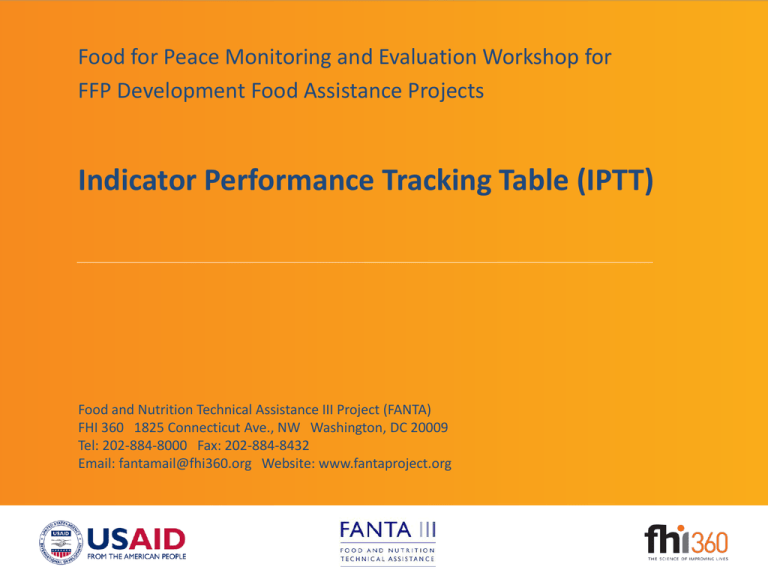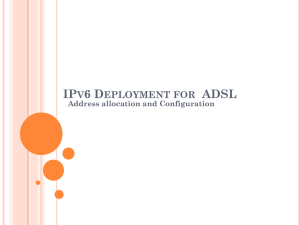
Food for Peace Monitoring and Evaluation Workshop for
FFP Development Food Assistance Projects
Indicator Performance Tracking Table (IPTT)
Food and Nutrition Technical Assistance III Project (FANTA)
FHI 360 1825 Connecticut Ave., NW Washington, DC 20009
Tel: 202-884-8000 Fax: 202-884-8432
Email: fantamail@fhi360.org Website: www.fantaproject.org
Session Objectives
By the end of this session, participants will have:
• Distinguished the difference between an
indicator, a target, an output indicator, outcome
indicator, and impact indicator
• Reviewed the “IPTT Checklist”
Indicator Performance Tracking Table (IPTT)
Session Outline
• Introduction
• Linking indicators to LogFrames
• IPTT checklist
Indicator Performance Tracking Table (IPTT)
The IPTT
LogFrame
IPTT
Indicator Performance Tracking Table (IPTT)
IPTT is a Living Document
DEVELOPED
at project
launch
USED
during project
implementation
UPDATED
annually
Monitoring
Are the indicators
working?
Analysis
Are we collecting
the info we need?
Reporting
Indicator Performance Tracking Table (IPTT)
What can be
improved?
IPTT Checklist
Provides criteria for reviewing an IPTT to help
ensure that it:
• Helps you improve your project
• Helps you meet your reporting requirements
• Helps you tell your story
Indicator Performance Tracking Table (IPTT)
Key M&E Terms for FFP Projects
Indicator Performance Tracking Table (IPTT)
Linking Indicators to LogFrames
Log-Frame
Indicator Performance Tracking Table (IPTT)
IPTT
LogFrames
Approximate Correlation Between
LogFrame and Indicator Levels
Impact and Outcome
Indicators
• Goal
• Purpose
Outcome Indicators
• Sub-purpose
• Immediate outcomes
Output and Process
Indicators
• Output
• Input
Indicator Performance Tracking Table (IPTT)
LogFrames
Monitoring at every level helps
pinpoint where a barrier may exist
Goal: Poverty reduced
Household incomes
remained unchanged.
Purpose: Farm
incomes increased
Sub-Purpose: Production of nontraditional crops increased
Immediate Outcome:
Knowledge of how to use new
seeds varieties increased
Outputs/Inputs: We train farmers
from 50 households to use new seeds;
we distribute seeds and fertilizer
Indicator Performance Tracking Table (IPTT)
Only 5 of 50 households
produced the new crop.
80% of farmers
remembered what
they learned.
Families had to
eat the seeds during
the hungry months
1 bag of seed and 5 bags of fertilizer
distributed to 50 households; 50 households
trained in cultivation of new crop.
IPTT checklist:
What to ask yourself when
developing or assessing your IPTT?
Indicator Performance Tracking Table (IPTT)
IPTT
Checklist
What Jobs Can Your Indicators Do?
• Improve your project
• Reporting requirements
• Tell your story
Indicator Performance Tracking Table (IPTT)
IPTT
Checklist
Approximate Correlation between
LogFrame and Indicator Levels
Impact and Outcome
Indicators
• Goal
• Purpose
Outcome Indicators
• Sub-purpose
• Immediate outcomes
Output and Process
Indicators
• Output
• Input
Indicator Performance Tracking Table (IPTT)
IPTT
Checklist
Is the Indicator Precise and WellDefined?
Which is more precise?
1. “% of children malnourished”
OR
2. “% of children 0–59 months in the target
population who are underweight (weight-for-age
z-score < -2)”
Indicator Performance Tracking Table (IPTT)
IPTT Checklist:
Is it FEASIBLE to collect and analyze the data
for each indicator?
Indicator Performance Tracking Table (IPTT)
IPTT
Checklist
Is it FEASIBLE to Collect and
Analyze the Data for Each Indicator?
a) Population-based household survey vs. project
records
b) Expertise to measure indicator
c) Timing of data collection
d) Sample size for reliable results
e) Recall period
f) Proxy indicator instead
g) Usefulness vs. cost
Indicator Performance Tracking Table (IPTT)
IPTT
Checklist
Is Each Target Reasonable?
a. Ambitious enough
b. Target based on past
performance
Indicator Performance Tracking Table (IPTT)
IPTT
Checklist
Does the IPTT Contain Not Too
Many and Not Too Few Indicators?
“Everything that can be counted
does not necessarily count;
everything that counts cannot
necessarily be counted.” (Einstein)
Indicator Performance Tracking Table (IPTT)
IPTT
Checklist
Does the IPTT Contain a Balance of
Output, Outcome, and Impact Indicators?
• You should be able to tell the story up and down each level of
the project theory or the LogFrame hierarchy
• Avoid “filling up” the IPTT with output indicators
PROJECT GOAL: Reduce food insecurity of vulnerable populations in Western Province
Purpose 1: Improved health status of children under 5 years of age
Indicator
+/-
BL
Yr2
Tar
Yr3
Tar
Yr4
Tar
Percentage of children 0-5 months of age in the
implementing zone who are exclusively breastfed
(+)
70
-
-
85
% of direct beneficiary infants 0-5 months of age who
are fed exclusively with breast milk
(+)
70
90
90
95
Indicator Performance Tracking Table (IPTT)
IPTT
Checklist
Does the IPTT Include Required Gender
Indicators?
Your IPTT should include:
• 8 required gender indicators for baseline/final evaluation (BL/FE)
surveys
• 1 required gender related ‘F’ indicator (annual monitoring)
• Sex disaggregation for FFP BL/FE and annual monitoring indicators
(where applicable)
Indicator Performance Tracking Table (IPTT)
IPTT
Checklist
Does the IPTT Include Environmental
Indicators Appropriate to Your LogFrame?
Your IPTT should include:
• FFP Required if Applicable (RiA) “stand-alone” environmental
indicators for baseline/final evaluation (BL/FE) surveys
• Use of environmental “integration” indicators for FFP BL/FE and
annual monitoring indicators (where applicable)
Indicator Performance Tracking Table (IPTT)
IPTT
Checklist
Use Standard International Indicators
Using standard indicators:
• Draws from international sources
• More easily agreed upon definitions
• Comparability of results across FFP projects and
countries
• Easier to learn from other project results
• Saves cost
Don’t reinvent the wheel!
Indicator Performance Tracking Table (IPTT)
IPTT
Checklist
Use Standard International Indicators
Some sources of standard international indicators:
• Agri-Gender Statistics Toolkit
• Description of an Agricultural Module for the Population
and Housing Census
• Demographic and Health Surveys
• Knowledge Practices and Coverage Surveys
• The Joint Monitoring Programme (JMP) for Water Supply
and Sanitation by WHO and UNICEF
• WASHplus
Indicator Performance Tracking Table (IPTT)
IPTT
Checklist
Are Indicators Labeled/Numbered
Clearly?
• Is the Funder requiring the indicator to be labeled as such? (i.e., FFP, Mission,
NGO)
• Are indicators numbered clearly, and are the “Required” and “Required if
Applicable” indicators listed? (with unique identifying number for each indicator)
• Is the wording for each indicator neutral? (e.g., “% of children exclusively
breastfed until 6 months” NOT “increase in the % of children exclusively
breastfed until 6 months”)
PROJECT GOAL: Reduce food insecurity of vulnerable populations in Western Province
Purpose 1: Improved livelihood capacities of vulnerable households
1.2 Average Household Dietary Diversity Score (FFP)
(+)
1.3 Percent of trained beneficiaries scoring 70% or
above on post-test scores
(+)
Indicator Performance Tracking Table (IPTT)
IPTT
Checklist
•
•
•
•
Are all the Targets in the Right Place?
Annual
Baseline
Midterm Evaluation
Final Evaluation)
PROJECT GOAL: Reduce food insecurity of vulnerable populations in Western Province
Purpose 1: Improved health status of children under 5 years of age
Indicator
+/-
BL
Yr2
Tar
Yr3
Tar
Yr4
Tar
Percentage of children 0–5 months of age in the
implementing zone who are exclusively breastfed
(+)
70
-
-
85
Percentage of direct beneficiary children 0–5 months
of age who are exclusively breastfed
(+)
90
90
Indicator Performance Tracking Table (IPTT)
IPTT
Checklist
Include All Applicable Disaggregation
PROJECT GOAL: Reduce food insecurity of vulnerable populations in Western Province
Purpose 1: Improved health status of children under 5 years of age
Indicator
+/-
Percentage of direct beneficiary children 0–5 months
of age who are exclusively breastfed
(+)
Yr2
Tar
Yr3
Tar
90
90
Male
90
90
Female
90
90
Indicator Performance Tracking Table (IPTT)
BL
Yr4
Tar
IPTT
Checklist
Targets
• Are targets clearly defined as
cumulative or not?
• Do all targets match their indicator
in units/are they in same format as
the indicator? (for example,
indicator says “Number of …” but
target says “50%”)
Indicator Performance Tracking Table (IPTT)
IPTT
Checklist
Applying IPTT checklist
20 MIN
• (15 min) Work in pairs, select a limited number of
indicators from your own IPTT (e.g. 5 indicators) and
apply the checklist.
• (5 min) Discuss questions/concerns with whole
group
Indicator Performance Tracking Table (IPTT)
IPTT Template
Indicator Performance Tracking Table (IPTT)
This presentation is made possible by the generous support of the
American people through the support of the Office of Health,
Infectious Diseases and Nutrition, Bureau for Global Health, and
Office of Food for Peace, Bureau for Democracy, Conflict and
Humanitarian Assistance, United States Agency for International
Development (USAID) under terms of Cooperative Agreement No.
AID-OAA-A-12-00005, through the Food and Nutrition Technical
Assistance III Project (FANTA), managed by FHI 360. The contents are
the responsibility of FHI 360 and do not necessarily reflect the views
of USAID or the United States Government.
Indicator Performance Tracking Table (IPTT)






